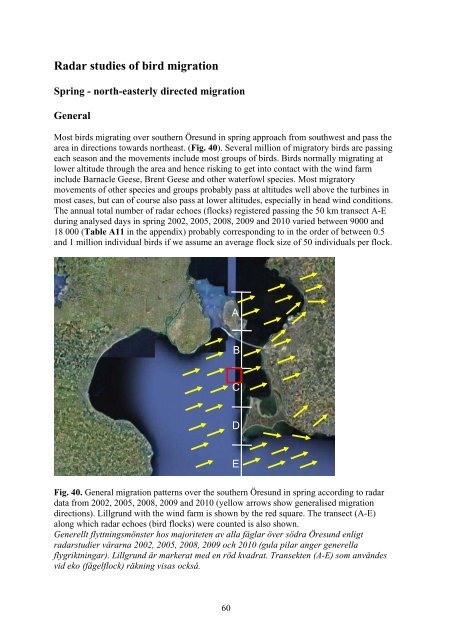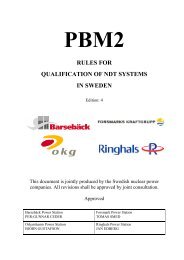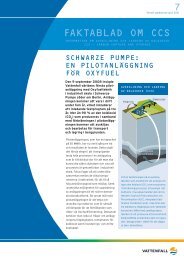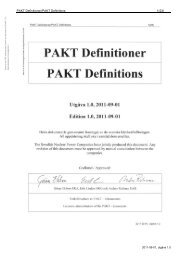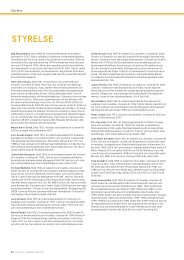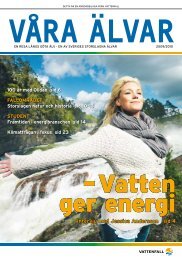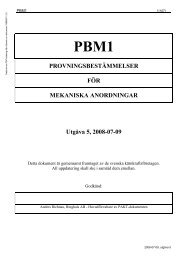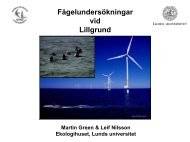Birds in southern Öresund in relation to the wind farm at ... - Vattenfall
Birds in southern Öresund in relation to the wind farm at ... - Vattenfall
Birds in southern Öresund in relation to the wind farm at ... - Vattenfall
Create successful ePaper yourself
Turn your PDF publications into a flip-book with our unique Google optimized e-Paper software.
Radar studies of bird migr<strong>at</strong>ion<br />
Spr<strong>in</strong>g - north-easterly directed migr<strong>at</strong>ion<br />
General<br />
Most birds migr<strong>at</strong><strong>in</strong>g over <strong>sou<strong>the</strong>rn</strong> <strong>Öresund</strong> <strong>in</strong> spr<strong>in</strong>g approach from southwest and pass <strong>the</strong><br />
area <strong>in</strong> directions <strong>to</strong>wards nor<strong>the</strong>ast. (Fig. 40). Several million of migra<strong>to</strong>ry birds are pass<strong>in</strong>g<br />
each season and <strong>the</strong> movements <strong>in</strong>clude most groups of birds. <strong>Birds</strong> normally migr<strong>at</strong><strong>in</strong>g <strong>at</strong><br />
lower altitude through <strong>the</strong> area and hence risk<strong>in</strong>g <strong>to</strong> get <strong>in</strong><strong>to</strong> contact with <strong>the</strong> w<strong>in</strong>d <strong>farm</strong><br />
<strong>in</strong>clude Barnacle Geese, Brent Geese and o<strong>the</strong>r w<strong>at</strong>erfowl species. Most migra<strong>to</strong>ry<br />
movements of o<strong>the</strong>r species and groups probably pass <strong>at</strong> altitudes well above <strong>the</strong> turb<strong>in</strong>es <strong>in</strong><br />
most cases, but can of course also pass <strong>at</strong> lower altitudes, especially <strong>in</strong> head w<strong>in</strong>d conditions.<br />
The annual <strong>to</strong>tal number of radar echoes (flocks) registered pass<strong>in</strong>g <strong>the</strong> 50 km transect A-E<br />
dur<strong>in</strong>g analysed days <strong>in</strong> spr<strong>in</strong>g 2002, 2005, 2008, 2009 and 2010 varied between 9000 and<br />
18 000 (Table A11 <strong>in</strong> <strong>the</strong> appendix) probably correspond<strong>in</strong>g <strong>to</strong> <strong>in</strong> <strong>the</strong> order of between 0.5<br />
and 1 million <strong>in</strong>dividual birds if we assume an average flock size of 50 <strong>in</strong>dividuals per flock.<br />
Fig. 40. General migr<strong>at</strong>ion p<strong>at</strong>terns over <strong>the</strong> <strong>sou<strong>the</strong>rn</strong> <strong>Öresund</strong> <strong>in</strong> spr<strong>in</strong>g accord<strong>in</strong>g <strong>to</strong> radar<br />
d<strong>at</strong>a from 2002, 2005, 2008, 2009 and 2010 (yellow arrows show generalised migr<strong>at</strong>ion<br />
directions). Lillgrund with <strong>the</strong> w<strong>in</strong>d <strong>farm</strong> is shown by <strong>the</strong> red square. The transect (A-E)<br />
along which radar echoes (bird flocks) were counted is also shown.<br />
Generellt flyttn<strong>in</strong>gsmönster hos majoriteten av alla fåglar över södra <strong>Öresund</strong> enligt<br />
radarstudier vårarna 2002, 2005, 2008, 2009 och 2010 (gula pilar anger generella<br />
flygriktn<strong>in</strong>gar). Lillgrund är marker<strong>at</strong> med en röd kvadr<strong>at</strong>. Transekten (A-E) som användes<br />
vid eko (fågelflock) räkn<strong>in</strong>g visas också.<br />
60<br />
A<br />
B<br />
C<br />
D<br />
E


